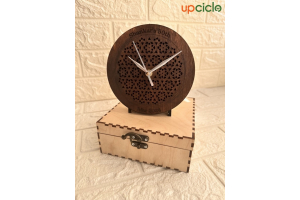Imperfect, Positive and Organic
In a constant chase for the best aesthetic appearance of everything we make or buy, we have little or no consideration for sustainability of the materials used, and the methods by which they are sourced. We often end up wasting resources that can be of good use, even if it means trimming off the extra crusty bits of your freshly made waffle, which taste just as good but may not add up for the attractive visual factor. We do the same with other practices in our lifestyle when we choose our clothing, design our living spaces and whatnot. It becomes very difficult to track the sources of every product you consume, but it is always helpful to educate oneself on the impact of production, wastage and disposal of these things.
Old buildings were mostly constructed with mud, clay and organic materials which had naturally sustainable cooling and insulating properties. Eventually, people made the switch to cement, steel and glass, which started trapping more heat during the day and releasing it in the night, thereby causing the greenhouse effect. The same happened with utensils and daily use objects that were earlier made with earthen materials but eventually moved towards steel and other metallic resources. This resulted in people taking the interest to have a variety and large number of options in their home rather than the minimum numbers required for themselves. There are also a large number of plastics making their way into your home on a regular basis in the form of PET bottles, food grade polycarbonate containers which contain high levels of BPA, and are harmful in the long run.
While buying a product or an article of clothing, have you ever switched up the glossy, perfect finish for a matte, imperfect look? Have you ever considered buying clothing with natural dyes like Indigo blue and Turmeric yellow, rather than the chemical pigments that are unsustainably made with high wastage of resources? Instead of the nylons and other synthetic fibres, consider using eco-friendly fabrics like hemp, jute, bamboo, cotton, khadi and linen — instead of wearing out over time, these materials in fact become stronger with repeated use and tend to last much longer, retaining their quality.

Wabi Sabi is a view of life that celebrates the imperfection of things in nature, and implementing those organic forms of style in their daily lives. One can say this is one of the most sustainable, earth friendly practices where we can be satisfied with something that is imperfect, impermanent and incomplete in nature. It relies on natural forms, naturally unfinished surfaces with roughness, asymmetry and modesty. Wabi Sabi includes well-known practices like Japanese pottery, simple tea ceremonies, zen gardening and bonsai cultivation. It is meant to have a wholesome effect of fulfillment in the simplest forms of sustainable living.
These colourful dreamcatchers were made with fabric scraps and hand stitched by women workers. Wabi Sabi also lies in the use of earthy, free flowing objects that are simple; without additional colours, shapes etc. — like this coconut shell jug that can be used for hot and cold beverages, and is easy to clean. For one, we could all try using clay pots for our cooking once in a while, instead of the steel ones. These are known to bring out better flavour and in fact be quite heat resistant, while also being microwave and freezer safe. Clay is known to naturally keep things cool which makes them great for curd and salad dishes. Wabi Sabi though simple in nature, can also be aesthetically wholesome — like these bamboo baskets, since they are a naturally sourced material, handmade, and sustainable in their production.

Imperfections are beautiful in so many ways, and they are simply what make an object or a person unique. A shape that can’t be named, that which is uneven, coloured imperfectly, leaves a rich and memorable impression and also reinforces the cultural history from which everything we have today has evolved. Nowadays there is a trend of single log tabletops, which can also be seen as a way of embracing imperfection. Bags made with water hyacinth, jute, bamboo toothbrushes, rattan furniture, all of these are industries trying their best to stop the use of plastic and chemically toxic manufacturing processes of single-use products. Use cork coasters, paper straws and you will be closer to helping the environment out of its sorry situation. Avoid fur, leather and other fashion practices that increase the carbon footprint. Sustainability is not so difficult when we are mindful, and it definitely feels good to contribute to a healthier planet and safe future.




